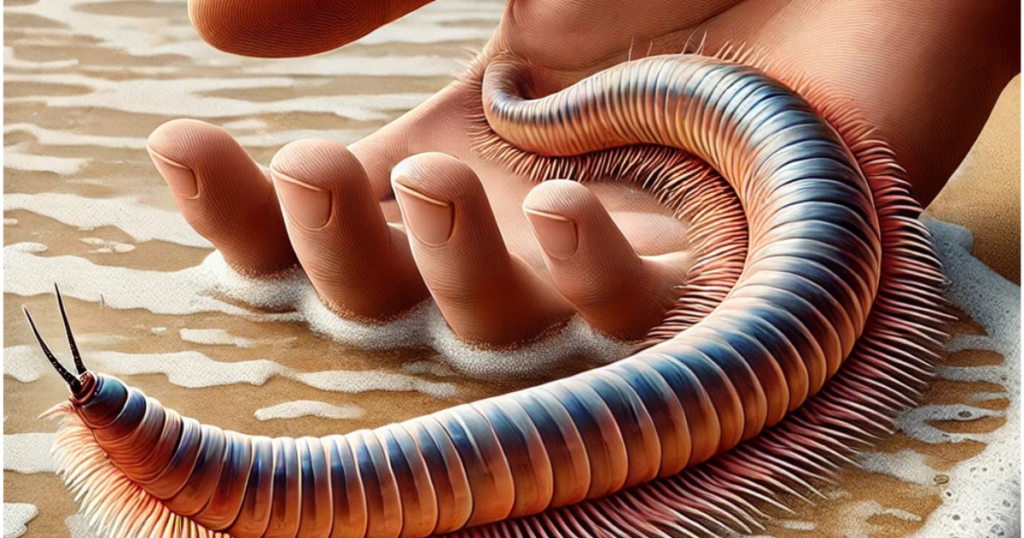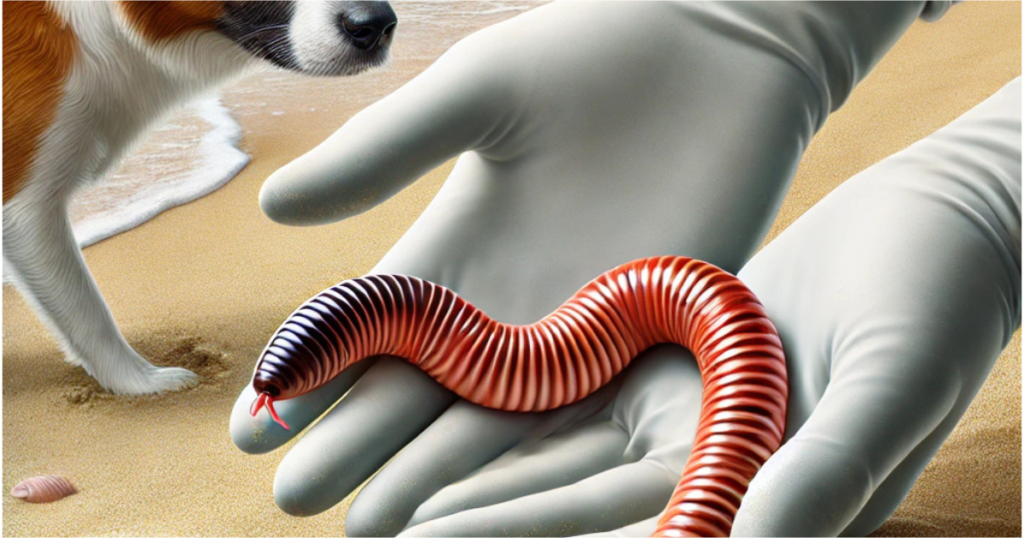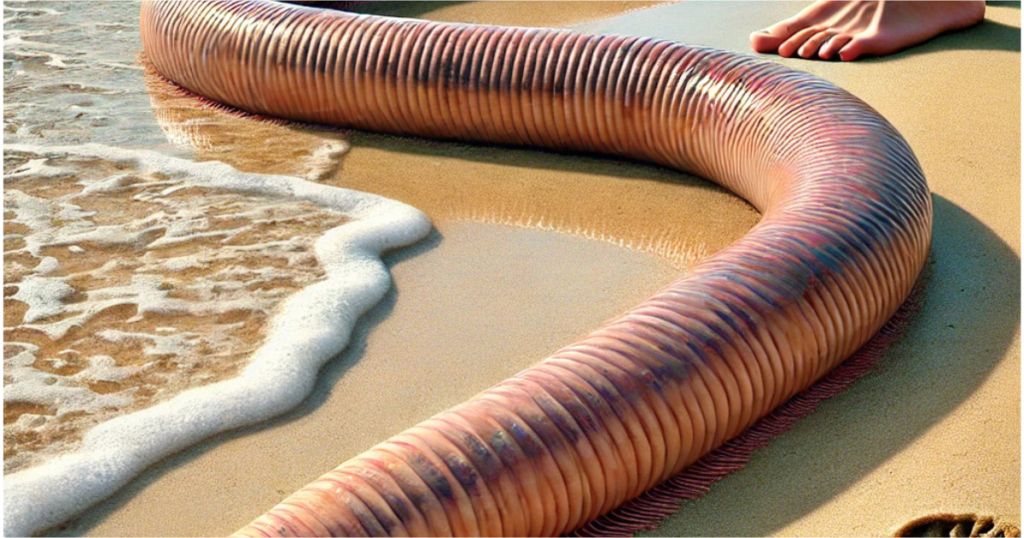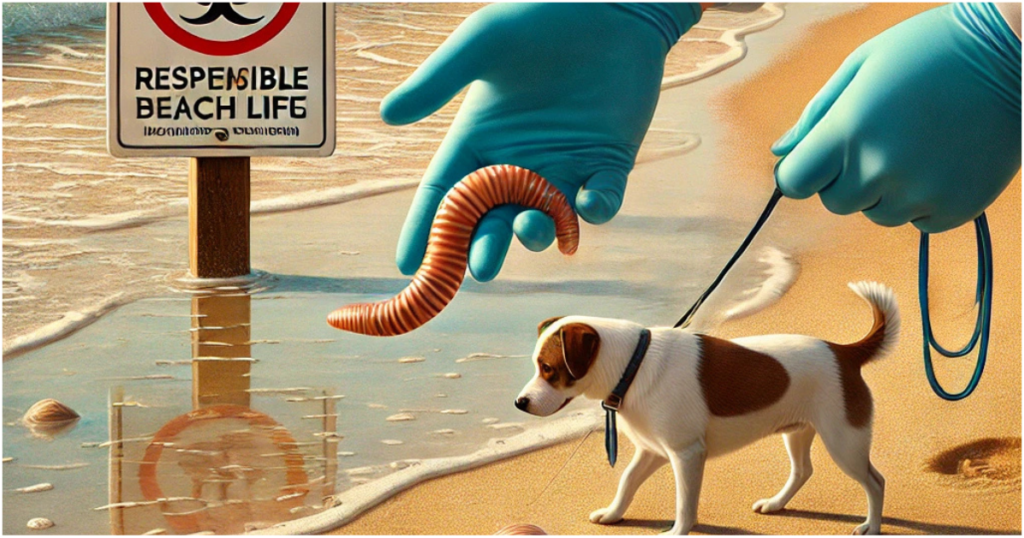Beach worms are intriguing creatures that inhabit sandy coastal areas around the world. While they are often used as bait by fishermen, many people wonder, “Are beach worms dangerous?” or more specifically, “Are beach worms dangerous to humans?”. In this detailed guide, we’ll explore the nature of beach worms, their potential risks, and answer related questions like “Are Australian beach worms dangerous?”, “Are giant beach worms dangerous?” and “Are beach worms dangerous to dogs and other animals?”

What Are Beach Worms?
Beach worms are marine annelids that belong to the family Onuphidae. They are commonly found on sandy beaches, where they burrow into the sand to create their homes. These worms are typically long and slender, with some species, like the giant beach worms, growing up to several feet in length.
Beach worms are most prevalent in regions like Australia, where they are often used as bait for fishing. Despite their somewhat intimidating appearance, these creatures are generally harmless and play a vital role in the coastal ecosystem by breaking down organic matter and aerating the sand.
Are beach worms dangerous to humans?
One of the most common questions people ask is, “Are beach worms dangerous to humans?” The answer is no—beach worms are not inherently dangerous to humans. They are non-venomous and do not possess any mechanisms to bite or sting.
However, there are a few things to keep in mind:
1: Sharp Bristles
Beach worms have tiny bristles called setae, which can cause minor irritation if you handle them improperly. For example, if you accidentally step on one or pick it up without gloves, you might feel a slight prickling sensation.

2: Allergic Reactions
While rare, some individuals may experience an allergic reaction to the bristles. If you notice redness, swelling, or itching after handling a beach worm, wash the affected area with soap and water and seek medical advice if necessary.
When it comes to Australian beach worms, the same principles apply. These worms are larger and more robust, but they are not harmful to humans. So, if you’re asking, “Are Australian beach worms dangerous to humans?”—rest assured, they pose no significant threat.
Are beach worms dangerous to dogs and other animals?
Pet owners often wonder, “Are beach worms dangerous to dogs or animals?” Generally, beach worms are not toxic or harmful to pets. However, there are a few considerations:

- Digestive Discomfort: If your dog digs up or eats a beach worm, it could lead to minor digestive discomfort. While beach worms are not poisonous, they are not part of a dog’s natural diet and may cause an upset stomach.
- Bristles: Just like in humans, the bristles on beach worms can cause irritation if they come into contact with your pet’s skin or mouth.
To keep your pets safe, it’s best to supervise them while at the beach and prevent them from digging up or eating beach worms.
Are giant beach worms dangerous?
Giant beach worms, such as the Australian Australonuphis, are among the largest species of beach worms. They can grow up to several feet long and are often found on the sandy shores of Australia. Despite their size, these worms are not dangerous to humans or animals.
Giant beach worms are primarily scavengers, feeding on dead fish and other organic matter. They are not aggressive and will typically retreat into the sand if disturbed. So, if you’re asking, “Are giant beach worms dangerous?”—the answer is no.
Is Beach Worms Safe?
When it comes to safety, beach worms are generally harmless to humans, dogs, and other animals. They are non-venomous, do not bite or sting, and are not aggressive. While their bristles can cause minor irritation if handled improperly, they pose no significant threat. For pet owners, beach worms are not toxic, but it’s best to prevent dogs from digging them up or eating them to avoid digestive discomfort. In summary, beach worms are safe as long as you handle them with care and respect their natural habitat.

Beach Worms and Their Role in the Ecosystem
Beach worms play a crucial role in maintaining the health of sandy beach ecosystems. Here’s how:
1: Decomposition
Beach worms feed on dead fish, seaweed, and other organic matter, helping to break it down and recycle nutrients back into the ecosystem.
2: Aeration
As beach worms burrow into the sand, they create tunnels that help aerate the sediment. This process improves the quality of the sand and benefits other marine organisms.
3: Food Source
Beach worms are an important food source for birds, fish, and other predators, making them a key part of the coastal food web.
Common Misconceptions About Beach Worms
Despite their harmless nature, beach worms are often misunderstood. Here are some common misconceptions:
1: They Are Venomous
Beach worms do not produce venom and are not capable of injecting toxins into humans or animals.
2: They Attack Humans
Beach worms are not aggressive and will not attack humans. They are more likely to retreat into the sand if disturbed.
3: They Are Parasites
Beach worms are not parasitic. They are free-living organisms that feed on organic matter in the sand.
Safety Tips for Handling Beach Worms
While beach worms are not dangerous, it’s always a good idea to handle them with care. Here are some tips:

- Wear Gloves: If you need to handle beach worms, wear gloves to protect your skin from their bristles.
- Avoid Stepping on Them: Be mindful of where you step on the beach to avoid accidentally crushing a beach worm.
- Supervise Pets: Keep an eye on your pets to prevent them from digging up or eating beach worms.
Beach Worms Around the World
Beach worms are found in sandy coastal areas around the world, but they are most commonly associated with Australia. If you’re visiting beaches like Karekare Beach or Muriwai Beach, you might encounter these fascinating creatures. While they are harmless, it’s always a good idea to be cautious and avoid disturbing their natural habitat.
For those planning a beach trip, it’s worth learning about potential dangers at popular beaches. Check out our guides on why Bondi Beach is so dangerous and why Myrtle Beach is so dangerous for more information.
- Why Is Myrtle Beach So Dangerous?
- Why Is Piha Beach So Dangerous?
- About Piha Beach
- What is the Maori History of Piha Beach? Exploring the Cultural Legacy of New Zealand’s Iconic Destination
Conclusion
In conclusion, beach worms are fascinating creatures that play a vital role in maintaining the health of sandy beach ecosystems. Despite their somewhat intimidating appearance, they are not dangerous to humans, dogs, or other animals. Whether you’re asking, “Are beach worms dangerous to humans?”, “Are Australian beach worms dangerous?”, or “Are giant beach worms dangerous?”, the answer remains the same—they are harmless.
These worms are scavengers that help break down organic matter and aerate the sand, making them an essential part of the coastal environment. While their bristles can cause minor irritation, this is easily avoided by handling them with care or wearing gloves. For pet owners, supervision is key to ensuring your dogs or other animals don’t ingest beach worms, which could lead to mild digestive issues.
If you’re planning a beach trip and encounter beach worms, there’s no need to worry. They are more of a curiosity than a threat. By understanding their behavior and role in the ecosystem, you can appreciate these unique creatures without fear.
For more information on beach safety and potential dangers at popular beaches, check out our guides on why Bondi Beach is so dangerous and why Myrtle Beach is so dangerous.
So, the next time you’re at the beach and spot a beach worm, take a moment to appreciate its role in nature. These creatures are a testament to the diversity and complexity of coastal ecosystems, and they remind us of the importance of preserving these environments for future generations. Beach worms may look unusual, but they are a safe and fascinating part of the beach experience.
FAQs
1. Are beach worms dangerous to humans?
No, beach worms are not dangerous to humans. They are non-venomous and do not bite or sting. However, their bristles can cause minor irritation if handled improperly.
2. Are Australian beach worms dangerous?
Australian beach worms, while larger and more robust, are not dangerous to humans. They are harmless and play an important role in the coastal ecosystem.
3. Are giant beach worms dangerous?
Giant beach worms, such as the Australian Australonuphis, are not dangerous. Despite their size, they are non-aggressive and primarily feed on dead organic matter.
4. Are beach worms dangerous to dogs or other animals?
Beach worms are not toxic to dogs or other animals. However, if ingested, they may cause minor digestive discomfort. It’s best to supervise pets to prevent them from eating beach worms.
5. What should I do if I accidentally step on a beach worm?
If you step on a beach worm, you may feel a slight prickling sensation from their bristles. Wash the affected area with soap and water to prevent irritation.
6. Can beach worms bite or sting?
No, beach worms do not have the ability to bite or sting. They are non-venomous and pose no threat to humans or animals.
7. What do beach worms eat?
Beach worms are scavengers that feed on dead fish, seaweed, and other organic matter found in the sand.
8. Where are beach worms commonly found?
Beach worms are commonly found in sandy coastal areas, particularly in regions like Australia. They burrow into the sand near the waterline.
9. How can I handle beach worms safely?
If you need to handle beach worms, wear gloves to protect your skin from their bristles. Avoid stepping on them and supervise pets to prevent them from digging up or eating beach worms.
10. Are beach worms beneficial to the environment?
Yes, beach worms play a crucial role in the ecosystem by breaking down organic matter and aerating the sand. They are also an important food source for birds and fish.
11. Can beach worms survive out of water?
Beach worms are adapted to live in moist, sandy environments. While they can survive briefly out of water, they need a damp habitat to thrive.
12. Are beach worms found in Maine or other non-Australian beaches?
Yes, beach worms can be found in sandy beaches worldwide, including regions like Maine. However, they are most commonly associated with Australian beaches.
13. Do beach worms have predators?
Yes, beach worms are preyed upon by birds, fish, and other coastal predators. They are an important part of the food web.
14. Can beach worms cause allergic reactions?
While rare, some individuals may experience mild allergic reactions to the bristles of beach worms. If you notice redness or swelling, wash the area and seek medical advice if necessary.
15. Are beach worms safe to touch?
Beach worms are safe to touch, but it’s best to wear gloves to avoid irritation from their bristles. Handle them gently and return them to their habitat after observation.

